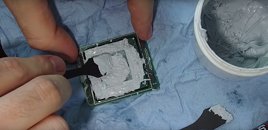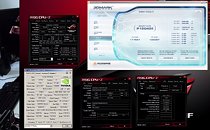Raevenlord
News Editor
- Joined
- Aug 12, 2016
- Messages
- 3,755 (1.19/day)
- Location
- Portugal
| System Name | The Ryzening |
|---|---|
| Processor | AMD Ryzen 9 5900X |
| Motherboard | MSI X570 MAG TOMAHAWK |
| Cooling | Lian Li Galahad 360mm AIO |
| Memory | 32 GB G.Skill Trident Z F4-3733 (4x 8 GB) |
| Video Card(s) | Gigabyte RTX 3070 Ti |
| Storage | Boot: Transcend MTE220S 2TB, Kintson A2000 1TB, Seagate Firewolf Pro 14 TB |
| Display(s) | Acer Nitro VG270UP (1440p 144 Hz IPS) |
| Case | Lian Li O11DX Dynamic White |
| Audio Device(s) | iFi Audio Zen DAC |
| Power Supply | Seasonic Focus+ 750 W |
| Mouse | Cooler Master Masterkeys Lite L |
| Keyboard | Cooler Master Masterkeys Lite L |
| Software | Windows 10 x64 |
Overclocker extraordinaire Der8auer has been able to put Intel's flagship, HCC HEDT 7980XE CPU, through its paces under extreme cooling, which resulted in a veritable show of force from the blue giant. Intel's $1,979, 18-core, 36-thread CPU has cemented itself as the flagship consumer CPU of choice, surpassing AMD's 1950X Threadripper in all fields. And yes, we do mean single-core and multi-core benchmarks, but also power consumption figures.
With 18 cores in need of adequate cooling, every piece of real-estate that may serve as an heatsink of sorts comes at a premium; that is why thermal paste for this Intel processor was applied not only to the CPU die itself, but also to the entire PCB around it. Der8auer says that doing this allows heat to be better dissipated form the CPU die, allowing for up to 400 MHz increased clock-speeds under load. Direct contact with the die was also tried, and achieved by cutting off the central pat of the IHS, while keeping the edges of it as a way of better load balancing the weight of the cooler (in this case, an LN2 cooler) over the CPU's PCB, in order to avoid different amounts of pressure on the CPU pins. However, the extreme overclocker ended up not recommending that venue, for it didn't offer consistent success in their extreme cooling efforts.




Compared to a Ryzen Threadripper 1950X @ 5.4 GHz on all cores, under LN2, which achieved a 4514 score in Cinebench R15. Intel 7980XE @ 5.6 GHz, achieved 5635 multi-threaded and 257 single-threaded points in the same benchmark. Der8auer estimates that 24/7 stable overclocks on the Intel 7980XE would achieve around 190 points in Cinebench's single thread workloads, while a Ryzen Threadripper in the same conditions would be able to achieve between 160 and 170 points. Intel's platform clearly has the upper hand when it comes to overclocked CPU scores, though users do have to consider the platform differences between Intel's X299 and AMD's X399 platforms.


A quick check of the Intel 7980XE's power consumption showed around 70 Amps being pulled through the 12 V rail (of which the majority of its power delivery goes straight to that central processing unit), which means that the CPU was pulling around 840 W power ( 70 Amps x 12 V) at a relatively safe 5.5 GHz overclock. Those wattage numbers saw increases of up to 1000 W in more radical 5.8, 6 GHz overclocks. These were achieved with a vCore of 1.45 V, which isn't really that high a value compared to historical Intel CPU overclocks - be these through extreme or more conventional cooling methods. Mindbogglingly, the Intel 7980XE was delivering temperature readings that were above 0 ºC, in a cooling loop that placed LN2 at -100 ºC in contact with the heat-spreader. This means the Intel CPU was able to surpass in heat production the -100 ºC of the LN2 cooling. Final overclocking values that successfully completed a loop of Cinebench's R15 benchmark on the multi-threaded test reached 6.1 GHz on all 18 cores, with Hyper Threading active.


Making use of an NVIDIA Titan Xp graphics card ( with modded voltage values and power limit), under LN2 cooling as well, saw the card reaching 2455 MHz on the GPU core. This score stands a little conservative when compared to some GTX 1080 Ti's overclocking, which saw in excess of 2700 MHz being achieved, but the wider, beefier computing resources present on NVIDIA's flagship graphics card in terms of pure shader count meant that this Titan Xp, paired with Intel's 7980XE processor under a 5.5 GHz core clock, saw it achieving 45,705 points under 3D Mark 11, 35,782 points in Fire Strike, and 120,425 points in 3D Mark Vantage. Not too shabby for some day's work, wouldn't you say? Feel free to take a look at Der8auer's work - and video - in the below embed.





View at TechPowerUp Main Site
With 18 cores in need of adequate cooling, every piece of real-estate that may serve as an heatsink of sorts comes at a premium; that is why thermal paste for this Intel processor was applied not only to the CPU die itself, but also to the entire PCB around it. Der8auer says that doing this allows heat to be better dissipated form the CPU die, allowing for up to 400 MHz increased clock-speeds under load. Direct contact with the die was also tried, and achieved by cutting off the central pat of the IHS, while keeping the edges of it as a way of better load balancing the weight of the cooler (in this case, an LN2 cooler) over the CPU's PCB, in order to avoid different amounts of pressure on the CPU pins. However, the extreme overclocker ended up not recommending that venue, for it didn't offer consistent success in their extreme cooling efforts.




Compared to a Ryzen Threadripper 1950X @ 5.4 GHz on all cores, under LN2, which achieved a 4514 score in Cinebench R15. Intel 7980XE @ 5.6 GHz, achieved 5635 multi-threaded and 257 single-threaded points in the same benchmark. Der8auer estimates that 24/7 stable overclocks on the Intel 7980XE would achieve around 190 points in Cinebench's single thread workloads, while a Ryzen Threadripper in the same conditions would be able to achieve between 160 and 170 points. Intel's platform clearly has the upper hand when it comes to overclocked CPU scores, though users do have to consider the platform differences between Intel's X299 and AMD's X399 platforms.


A quick check of the Intel 7980XE's power consumption showed around 70 Amps being pulled through the 12 V rail (of which the majority of its power delivery goes straight to that central processing unit), which means that the CPU was pulling around 840 W power ( 70 Amps x 12 V) at a relatively safe 5.5 GHz overclock. Those wattage numbers saw increases of up to 1000 W in more radical 5.8, 6 GHz overclocks. These were achieved with a vCore of 1.45 V, which isn't really that high a value compared to historical Intel CPU overclocks - be these through extreme or more conventional cooling methods. Mindbogglingly, the Intel 7980XE was delivering temperature readings that were above 0 ºC, in a cooling loop that placed LN2 at -100 ºC in contact with the heat-spreader. This means the Intel CPU was able to surpass in heat production the -100 ºC of the LN2 cooling. Final overclocking values that successfully completed a loop of Cinebench's R15 benchmark on the multi-threaded test reached 6.1 GHz on all 18 cores, with Hyper Threading active.


Making use of an NVIDIA Titan Xp graphics card ( with modded voltage values and power limit), under LN2 cooling as well, saw the card reaching 2455 MHz on the GPU core. This score stands a little conservative when compared to some GTX 1080 Ti's overclocking, which saw in excess of 2700 MHz being achieved, but the wider, beefier computing resources present on NVIDIA's flagship graphics card in terms of pure shader count meant that this Titan Xp, paired with Intel's 7980XE processor under a 5.5 GHz core clock, saw it achieving 45,705 points under 3D Mark 11, 35,782 points in Fire Strike, and 120,425 points in 3D Mark Vantage. Not too shabby for some day's work, wouldn't you say? Feel free to take a look at Der8auer's work - and video - in the below embed.





View at TechPowerUp Main Site
Last edited:










